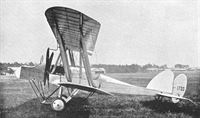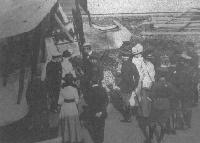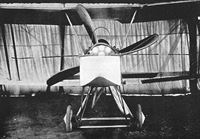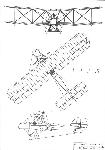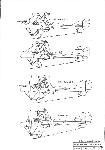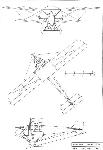
Описание
Страна: Великобритания
Год: 1915
Варианты
- RAF - B.E.1 - 1911 - Великобритания
- RAF - B.E.2/B.E.2a/B.E.2b - 1912 - Великобритания
- RAF - B.E.3 / B.E.4 / B.E.7 - 1912 - Великобритания
- RAF - B.E.8 - 1913 - Великобритания
- RAF - B.E.2c/B.E.2d - 1914 - Великобритания
- RAF - B.E.9 - 1915 - Великобритания
- RAF - B.E.12 - 1916 - Великобритания
- RAF - B.E.2e - 1916 - Великобритания
- P.Hare Royal Aircraft Factory (Putnam)
- J.Bruce British Aeroplanes 1914-1918 (Putnam)
- H.King Armament of British Aircraft (Putnam)
-
J.Bruce - British Aeroplanes 1914-1918 /Putnam/
This view of the B.E.9 clearly illustrates the reason for the observer's sense of isolation.
-
J.Herris - Weird Wings of WWI /Centennial Perspective/ (70)
Developed from the B.E.2, the B.E.9 featured the same 'pulpit' gunner's cockpit configuration as the Spad SA series. B.E.9 serial 1700 was sent for operational testing in France in September 1915; Capt Robin Rowell test flew this and said he was happy it was crashed. (Greg VanWyngarden)
-
P.Hare - Royal Aircraft Factory /Putnam/
The B.E.9 is shown to HM King George V during his visit to Farnborough on 18 August 1915.
-
J.Bruce - British Aeroplanes 1914-1918 /Putnam/
Experimental installation of multiple pitot heads on B.E.9.
P.Hare Royal Aircraft Factory (Putnam)
B.E.9
As it became ever more apparent that the British flying services urgently needed an aeroplane suitably armed for an offensive role, and as no synchronisation mechanism was yet available to the Allies to enable a machine gun to be fired through the propeller disc, the most obvious solution appeared to be the pusher layout. However, although it offered an unrivalled forward field of fire, the pusher suffered from the additional drag of its tailbooms, and could never match the performance of a well-designed tractor of similar power. In a bold attempt to combine the pusher's field of fire and the tractor's performance in one aeroplane, the B.E.9 was conceived.
It was built, in mid-1915, by the conversion of the Bristol-built B.E.2c 1700, thereby continuing the tradition of 'reconstruction'. The observer's cockpit was eliminated, and the engine was moved back to occupy the space thus gained, the propeller being located about twelve inches in front of the leading edge of the upper wing. The wingspan was increased by the provision of a new, wider centre section, the cabane struts being raked outwards to clear the cylinders of the relocated engine. A gap was left at the root of the lower wing to improve the pilot's downward view. A plywood nacelle was mounted, via a ball-race, on the forward end of the propeller shaft, and braced to the undercarriage by a system of struts. Additional bracing was provided by wires running out to the wings. A greatly enlarged fin was fitted to offset the additional side area forward of the centre of gravity, but the standard rudder was retained.
The Pulpit, as it almost inevitably became known, was presented for final inspection on 14 August and taken up for a brief first flight later the same day, with Frank Goodden at the controls. It was passed to the Central Flying School for service trials, their official report finding the design 'excellent', the stability 'very good', and the speed only slightly reduced from that of the B.E.2c. Communication between the crew was regarded as 'difficult' (which was something of an understatement considering that they were separated by the engine and propeller), and the report recommended that dual controls should be provided. Although finding a route for the necessary cables must have taxed the designers' ingenuity to the full, these were installed before the B.E.9 was flown to St Omer on 11 September so that it could be tested by crews from operational squadrons, Nos 6, 8 and 16 being among those selected.
Front-line pilots seem to have been almost unanimous in their condemnation of the machine. Lord Douglas of Kirtleside (then Lt Sholto Douglas) took it on a reconnaissance patrol over the lines on 26 October. He considered it 'ugly' and 'sluggish but very stable', and commented that his observer was, at best, 'lonely' in his little plywood box. Trenchard, then commanding the RFC in France, was equally unimpressed, and reported: 'this type of aeroplane cannot be recommended'.
The B.E.9 was therefore returned to the depot at St Omer and then, early in the new year, flown quietly back to Farnborough, where it was never heard of again.
A French machine, the SPAD A-2, which was of similar design, was likewise not widely adopted and, although the concept was adjudged to have been a failure, it is perhaps unfair to condemn a brave, if misguided, solution to a pressing problem.
Powerplant: 90hp R.A.F.1a V-8
Dimensions:
span 40ft 10 1/2in;
chord 5ft 6in;
gap 6ft 3in;
stagger 2ft 0in;
length 29ft 0in;
height 11ft 5in .
Performance:
max speed 82mph at sea level;
climb 4 1/2min to 1,000ft.
B.E.9a
A plan to build a variant of the B.E. 9 powered by the 140hp R.A.F.4a was, considering the unsuitability of its forebear, not proceeded with.
F.E.10
This projected single-seat scout was abandoned while still in the design stage. It was to have been a rather improbable and ill-conceived machine, with the cockpit in a 'pulpit' mounted in front of the propeller, in the manner of the unsuccessful B.E.9, presumably in an attempt to produce a fighter with a forward-firing gun without incurring the pusher's drag penalty. The fact that it was given a designation in the F.E. series demonstrates not only the degree to which the B.E. class had been discredited, but of the difficulty in placing each and every design concept into a 'pigeon hole'.
The F.E. 10 was to have been powered by the 150hp Hispano-Suiza V-8 engine, as was the S.E.5, the design of which was taking place concurrently. As the availability of gun synchronisation gears had rendered the pusher and 'pulpit' concepts out of date, and as demand for the Hispano continued to exceed supply, commonsense prevailed and the F.E. 10 project was dropped in favour of the more promising tractor design. It was, however, decided that the F.E.10's vertical tail surfaces were more pleasing than those originally designed for the S.E.5, and the latter's drawings were amended accordingly.
Dimensions
Span: 35ft 0in.
F.E.11
No record of this project has been discovered.
Описание:

